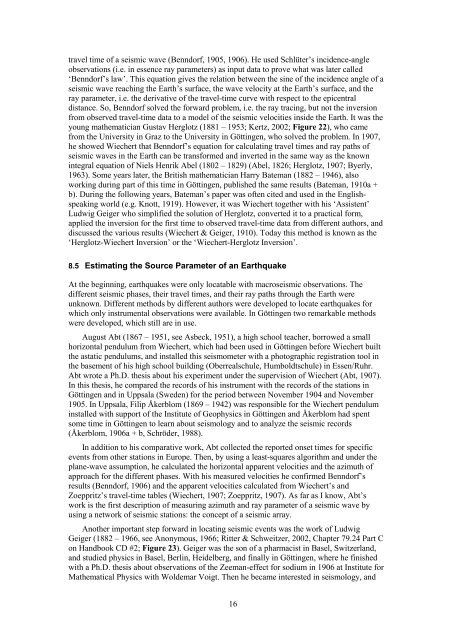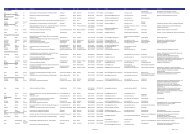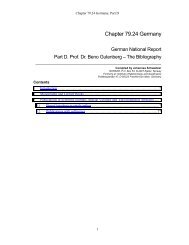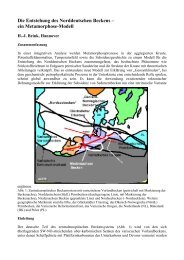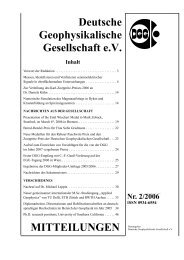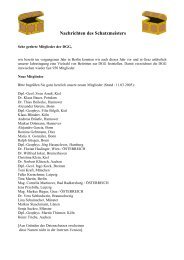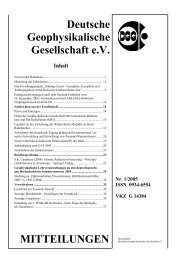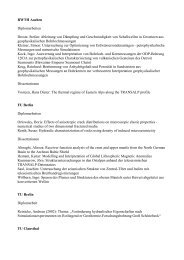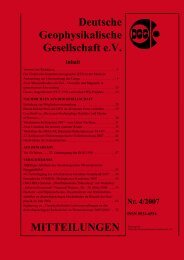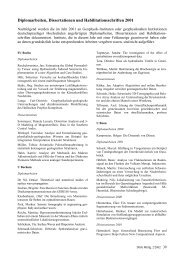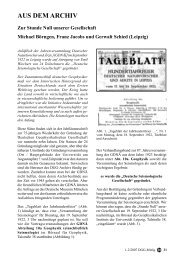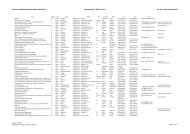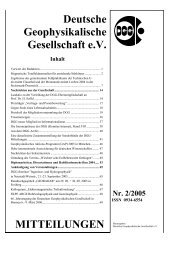Early Contributions to Modern Seismology - Deutsche ...
Early Contributions to Modern Seismology - Deutsche ...
Early Contributions to Modern Seismology - Deutsche ...
You also want an ePaper? Increase the reach of your titles
YUMPU automatically turns print PDFs into web optimized ePapers that Google loves.
travel time of a seismic wave (Benndorf, 1905, 1906). He used Schlüter’s incidence-angle<br />
observations (i.e. in essence ray parameters) as input data <strong>to</strong> prove what was later called<br />
‘Benndorf’s law’. This equation gives the relation between the sine of the incidence angle of a<br />
seismic wave reaching the Earth’s surface, the wave velocity at the Earth’s surface, and the<br />
ray parameter, i.e. the derivative of the travel-time curve with respect <strong>to</strong> the epicentral<br />
distance. So, Benndorf solved the forward problem, i.e. the ray tracing, but not the inversion<br />
from observed travel-time data <strong>to</strong> a model of the seismic velocities inside the Earth. It was the<br />
young mathematician Gustav Herglotz (1881 – 1953; Kertz, 2002; Figure 22), who came<br />
from the University in Graz <strong>to</strong> the University in Göttingen, who solved the problem. In 1907,<br />
he showed Wiechert that Benndorf’s equation for calculating travel times and ray paths of<br />
seismic waves in the Earth can be transformed and inverted in the same way as the known<br />
integral equation of Niels Henrik Abel (1802 – 1829) (Abel, 1826; Herglotz, 1907; Byerly,<br />
1963). Some years later, the British mathematician Harry Bateman (1882 – 1946), also<br />
working during part of this time in Göttingen, published the same results (Bateman, 1910a +<br />
b). During the following years, Bateman’s paper was often cited and used in the Englishspeaking<br />
world (e.g. Knott, 1919). However, it was Wiechert <strong>to</strong>gether with his ‘Assistent’<br />
Ludwig Geiger who simplified the solution of Herglotz, converted it <strong>to</strong> a practical form,<br />
applied the inversion for the first time <strong>to</strong> observed travel-time data from different authors, and<br />
discussed the various results (Wiechert & Geiger, 1910). Today this method is known as the<br />
‘Herglotz-Wiechert Inversion’ or the ‘Wiechert-Herglotz Inversion’.<br />
8.5 Estimating the Source Parameter of an Earthquake<br />
At the beginning, earthquakes were only locatable with macroseismic observations. The<br />
different seismic phases, their travel times, and their ray paths through the Earth were<br />
unknown. Different methods by different authors were developed <strong>to</strong> locate earthquakes for<br />
which only instrumental observations were available. In Göttingen two remarkable methods<br />
were developed, which still are in use.<br />
August Abt (1867 – 1951, see Asbeck, 1951), a high school teacher, borrowed a small<br />
horizontal pendulum from Wiechert, which had been used in Göttingen before Wiechert built<br />
the astatic pendulums, and installed this seismometer with a pho<strong>to</strong>graphic registration <strong>to</strong>ol in<br />
the basement of his high school building (Oberrealschule, Humboldtschule) in Essen/Ruhr.<br />
Abt wrote a Ph.D. thesis about his experiment under the supervision of Wiechert (Abt, 1907).<br />
In this thesis, he compared the records of his instrument with the records of the stations in<br />
Göttingen and in Uppsala (Sweden) for the period between November 1904 and November<br />
1905. In Uppsala, Filip Åkerblom (1869 – 1942) was responsible for the Wiechert pendulum<br />
installed with support of the Institute of Geophysics in Göttingen and Åkerblom had spent<br />
some time in Göttingen <strong>to</strong> learn about seismology and <strong>to</strong> analyze the seismic records<br />
(Åkerblom, 1906a + b, Schröder, 1988).<br />
In addition <strong>to</strong> his comparative work, Abt collected the reported onset times for specific<br />
events from other stations in Europe. Then, by using a least-squares algorithm and under the<br />
plane-wave assumption, he calculated the horizontal apparent velocities and the azimuth of<br />
approach for the different phases. With his measured velocities he confirmed Benndorf’s<br />
results (Benndorf, 1906) and the apparent velocities calculated from Wiechert’s and<br />
Zoeppritz’s travel-time tables (Wiechert, 1907; Zoeppritz, 1907). As far as I know, Abt’s<br />
work is the first description of measuring azimuth and ray parameter of a seismic wave by<br />
using a network of seismic stations: the concept of a seismic array.<br />
Another important step forward in locating seismic events was the work of Ludwig<br />
Geiger (1882 – 1966, see Anonymous, 1966; Ritter & Schweitzer, 2002, Chapter 79.24 Part C<br />
on Handbook CD #2; Figure 23). Geiger was the son of a pharmacist in Basel, Switzerland,<br />
and studied physics in Basel, Berlin, Heidelberg, and finally in Göttingen, where he finished<br />
with a Ph.D. thesis about observations of the Zeeman-effect for sodium in 1906 at Institute for<br />
Mathematical Physics with Woldemar Voigt. Then he became interested in seismology, and<br />
16


